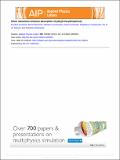Files in this item
Silver nanowires enhance absorption of poly(3-hexylthiophene)
Item metadata
| dc.contributor.author | Smolarek, Karolina | |
| dc.contributor.author | Ebenhoch, Bernd | |
| dc.contributor.author | Czechowski, Nikodem | |
| dc.contributor.author | Prymaczek, Aneta | |
| dc.contributor.author | Twardowska, Magdalena | |
| dc.contributor.author | Samuel, Ifor D. W. | |
| dc.contributor.author | Mackowski, Sebastian | |
| dc.date.accessioned | 2014-01-21T12:31:01Z | |
| dc.date.available | 2014-01-21T12:31:01Z | |
| dc.date.issued | 2013-11-11 | |
| dc.identifier | 91182571 | |
| dc.identifier | 607a1f1b-4690-4c72-8bcf-38495f993470 | |
| dc.identifier | 000327818700092 | |
| dc.identifier | 84889654795 | |
| dc.identifier.citation | Smolarek , K , Ebenhoch , B , Czechowski , N , Prymaczek , A , Twardowska , M , Samuel , I D W & Mackowski , S 2013 , ' Silver nanowires enhance absorption of poly(3-hexylthiophene) ' , Applied Physics Letters , vol. 103 , no. 20 , 203302 . https://doi.org/10.1063/1.4829623 | en |
| dc.identifier.issn | 0003-6951 | |
| dc.identifier.uri | https://hdl.handle.net/10023/4408 | |
| dc.description.abstract | Results of optical spectroscopy reveal strong influence of plasmon excitations in silver nanowires on the fluorescence properties of poly(3-hexylthiophene) (P3HT), which is one of the building blocks of organic solar cells. For the structure where a conductive polymer poly(3,4-ethylenedioxythiophene): poly(styrenesulfonate) was used as a spacer in order to minimize effects associated with non-radiative energy transfer from P3HT to metallic nanoparticles, we demonstrate over two-fold increase of the fluorescence intensity. Results of time-resolved fluorescence indicate that the enhancement of emission intensity can be attributed to increased absorption of P3HT. Our findings are a step towards improving the efficiency of organic solar cells through incorporation of plasmonic nanostructures. (C) 2013 AIP Publishing LLC. | |
| dc.format.extent | 4 | |
| dc.format.extent | 736880 | |
| dc.language.iso | eng | |
| dc.relation.ispartof | Applied Physics Letters | en |
| dc.subject | Solar-cells | en |
| dc.subject | Nanoparticles | en |
| dc.subject | QC Physics | en |
| dc.subject.lcc | QC | en |
| dc.title | Silver nanowires enhance absorption of poly(3-hexylthiophene) | en |
| dc.type | Journal article | en |
| dc.contributor.sponsor | EPSRC | en |
| dc.contributor.institution | University of St Andrews. School of Physics and Astronomy | en |
| dc.contributor.institution | University of St Andrews. Condensed Matter Physics | en |
| dc.identifier.doi | https://doi.org/10.1063/1.4829623 | |
| dc.description.status | Peer reviewed | en |
| dc.identifier.grantnumber | EP/I00243X/1 | en |
This item appears in the following Collection(s)
Items in the St Andrews Research Repository are protected by copyright, with all rights reserved, unless otherwise indicated.

